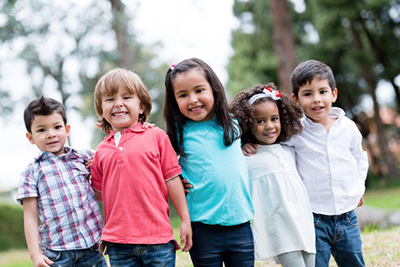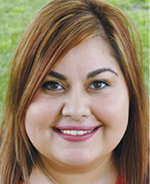Guide C-401
Reviewed by Jennah McKinley
College of Agricultural, Consumer and Environmental Sciences, New Mexico State University.
Author: Extension Family and Consumer Sciences Agent, Eddy County Extension Office, New Mexico State University. (Print friendly PDF)
A baby or young child cannot be expected to cooperate very much in the job of dressing. Many are far more interested in taking clothes off than putting them on! Some will be cooperative and enjoy being dressed while others will be a greater challenge.

© Andres Rodriguez | Dreamstime.com
Physical Development Influences Clothing
The rate of physical development and coordination varies from child to child. For almost all children, it is rapid during the early years; in the first year, an average child gains 12 to 14 pounds and grows 10 inches. Because of this rapid growth rate, clothing should be selected with “short-term” use in mind. Few items are needed—especially if a washer and dryer are available for daily use—but they should be of good quality fabric and durable construction. It is seldom practical to buy a large number of any item smaller than the 12- to 18-month size; smaller sizes will be quickly outgrown.
Children’s interest in clothing changes as their coordination and bodies develop. Here are a few general guidelines:
|
10 to 12 months |
Will extend arms and legs when being dressed. |
|
18 months |
Takes off socks and mittens, unzips zippers, tries to put on shoes. |
|
2 years |
Helps pull up or push down pants, removes shoes if untied, helps put arms in sleeves and legs in pants. |
|
3 years |
Can dress self with assistance, but has trouble distinguishing front from back and right from left. |
|
4 years |
Can dress self if given help with small fasteners and ties, undresses self. |
|
5 years |
Can dress and undress self. |
Clothes for Easy Dressing
Young children seldom like being dressed, so select garments that are easy to put on and take off. Avoid outfits that have several pieces that must be put on one at a time and items with lots of buttons, zippers, or snaps. To reduce dressing time struggles, avoid garments that must be pulled over the head. Or, select pullover tops that open on the shoulder to allow the garment to be slipped on quickly. Remember, a baby’s arms and legs are like an adult’s—only smaller—so don’t try to force a child’s limbs into garment openings by twisting and pulling them in uncomfortable directions.
Some self-help features to look for in clothing for young children include:
• Front openings or large neck openings
• Simple fasteners—large buttons are preferred
• Zippers with large pull rings
• An elastic waistline instead of a belt or sash
• Marks to identify front and back, right and left
• Easy-to-use pockets
Comfortable Clothing Is Important
Comfort is an important factor to consider when selecting children’s clothing. There are three main aspects of comfort to consider.
Temperature. Clothing can cause children to be uncomfortably warm or cool. Comfortable clothing will allow absorption and ventilation so that body moisture can evaporate easily. Cotton and cotton blend fabrics are absorbent and comfortable for small children. One hundred percent synthetic fabrics, which are usually nonabsorbent, are uncomfortable for children in warm weather. Give special consideration to a baby’s comfort if disposable diapers are used frequently. These diapers do not allows ventilation, and skin irritation may result if care is not taken.
Restriction. Children do not enjoy wearing clothing that restricts body movement. Clothing that is too small or too large can inhibit body movement and interfere with a child’s activities. Avoid uncomfortably small necklines, armholes, sleeves, and waistlines and elastic that is too tight. Clothing that is too large and twists around the body or trips the child should also be avoided.
Irritating textures. Harsh or scratchy fabrics, fasteners, and seam finishes can irritate a child’s sensitive skin. Clothing made from soft cotton or cotton blend fabrics are comfortable and easy to care for. Knitted fabrics are excellent choices for young children’s clothing because they:
• allow ventilation, yet give warmth;
• mold to the shape of the body without restricting body movement;
• are soft against the skin; and
• “stretch” to make dressing easier.
Be sure to check the construction of each garment to avoid bulky seams and scratchy fasteners. Heavy zippers, snaps, and buttons will be uncomfortable for the baby to lie on. Metal zippers may be rough and irritate the skin, and they can become uncomfortably warm if exposed to the sun for too long.
Safe Clothing for Little Ones
Clothing can cause young children to have accidents. Infants whose curiosity is aroused by fancy snaps, buttons, or trim may attempt to pull them off and swallow them. To avoid this, be certain these features on any garment are securely attached. Avoid garment decorations such as ball fringe, fancy zipper pulls, and other decorations that might be pulled off and swallowed by a curious child. Other clothing features to avoid include:
|
Type of Garment |
Accident |
|
Drawstrings at the neck |
Strangling |
|
Large pockets, legs, or garments and long sashes |
Falls |
|
Pajamas/paper products not fireproofed (costumes) |
Fires |
|
Safety pin without safety head |
Sticking |
|
Loose fasteners or buttons |
Swallowing |
For toddlers and preschoolers, brightly colored garments, especially red and yellow, can offer protection since motorists, busy mothers, and babysitters will be able to see the child more easily.
Appropriate Clothes for Young Children
Dress young children according to activities and the temperature of their surroundings. Select fabrics with temperature in mind—cotton for warm temperatures and synthetics for cool ones. The major activities to consider include:
Sleeping—A baby needs no more in the way of clothing or covering than an adult does. Knitted gowns with mittens on the sleeves are a good choice for infants. For little ones 6 months or older, select pajamas with feet. These will help keep the child warm even when blankets are kicked off during the night. All sleepwear for children is flame retardant, but it must be laundered correctly to maintain this quality. Follow care instructions carefully.
Eating—Small round bibs will absorb drooling and excess liquids from bottle or breast feeding. For babies on solid foods, a large bib of plastic or a combination of cloth backed with plastic will be useful. Pockets across the bottom of the bib to catch food will be helpful, and cloth binding at the neck will add comfort for the child.
Playing—For indoor play, choose stretch play suits, diaper-shirt sets, and gowns for small babies. Toddlers will enjoy coveralls, overalls, T-shirts, etc. For playing outdoors, toddlers will need shorts, tops, and overalls or shortalls for summer, and coveralls, corduroy pants, and sweaters (front openings) for winter.
Dress Up—Most adults like to “show off” their baby. They usually try to dress the young child to look especially “pretty.” Select garments for such occasions carefully. Avoid scratchy laces, stiff fabric, etc. Fancy, ruffled plastic pants, “cute” shoes, and caps may be uncomfortable for small children. Select garments of soft fabric similar to the everyday garments the child enjoys wearing. Remember that dressing up will not change the child’s behavior or habits—be sure all dress up clothes are easy to care for and comfortable to wear.
For further reading
F-108: Guiding Young Children
https://pubs.nmsu.edu/_f/F108/
F-109: Toilet Training for Toddlers
http://pubs.nmsu.edu/_f/F109/
F-112: Temper Tantrums
http://pubs.nmsu.edu/_f/F-112/
All Family Development publications
http://pubs.nmsu.edu/_f/
All Clothing publications
https://pubs.nmsu.edu/_c/
| Original author: Susan Wright, Extension Consumer Specialist. Subsequently revised by Constance Kratzer, Family Resource Management Specialist. |

Jennah McKinley is a Family and Consumer Sciences Agent and I-CAN Supervisor for NMSU’s Cooperative Extension Service Office in Eddy County. She earned her B.S. in family and consumer sciences education and her M.Ed. in online teaching and learning from NMSU. She specializes in community education and 4-H youth development. Her programs focus on parenting, childcare, nutrition, diabetes education, family resource management, and youth development.
To find more resources for your business, home, or family, visit the College of Agricultural, Consumer and Environmental Sciences on the World Wide Web at pubs.nmsu.edu
Contents of publications may be freely reproduced for educational purposes. All other rights reserved. For permission to use publications for other purposes, contact pubs@nmsu.edu or the authors listed on the publication.
New Mexico State University is an equal opportunity/affirmative action employer and educator. NMSU and the U.S. Department of Agriculture cooperating.
Reviewed October 2016


